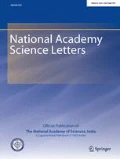Abstract
Plant growth promoting rhizobacteria are beneficial bacteria are one of the major groups of microbes that can be found in the rhizosphere, in association with roots which can enhance the growth of plant directly or indirectly. The present study aimed to isolate plant growth promoting and disease suppressing bacterial isolates native to rhizosphere soil and/or endophytic tissues of ginger plants from two different major growing location of each of Solan and Sirmour districts of H.P. (India). Nutrient agar, Jensen’s medium, Pikovskaya’s medium and soil extract medium are used for screening of microbial population associated with ginger and ginger roots, while for the population assessment, Pikovskaya’s medium was used. The highest microbial count on ginger was at Sirmour (Narag), while the PSB +ve colonies (87.72) and % P solublizers to PVK count (79.00) associated with ginger root was highest at Solan (Kandaghat), Himachal Pradesh.

References
Hitner L (1904) UE ber neuere Erfahrungen and Probleme auf dem Gebiet der Bodenbackteriologie und unter besonderer BeruEcksichtigung der GruEnduEngung und Brache. ArbeitenDeutscher LAndwirtschchafts Gesellschaft 98:59–78
Whipps JM (2001) Microbial interactions and biocontrol in the rhizosphere. J Exp Bot 52:487–511
Juanda JIH (2005) Screening of soil bacteria for plant growth promoting activities in vitro. J Agric Sci 4:27–31
Bloemberg GV, Lugtenberg BJJ (2001) Molecular basis of plant growth promotion and bio-control by rhizobacteria. Curr Opin Plant Biol 4:343–350
Bhattacharya PN (2012) Plant growth promoting rhizobacteria (PGPR): emergence in agriculture. World J Microbial Biotechnol 28(4):1327–1350
Ahmad F, Ahmad I, Khan MS (2008) Screening of free-living rhizospheric bacteria for their multiple plant growth promoting activities. Microbial Research 163(2):173–181
Vessey KJ (2003) Plant growth promoting rhizobacteria as biofertilizers. Plant Soil 255:571–586
Rai N, Yadav DS (2005) Advances in vegetable production., Spices and condiments XIIResearchco Book Centre, New Delhi, pp 886–889
Barakart MA, Gabr SM (1998) Effect of different biofertilizer types and nitrogen fertilizers types and nitrogen fertilizers level on tomato plants. Alex J Agric Res 43:149–160
Patra SK, Padhi AK, Mishra SN (1989) Effect of biofertilizers at graded level of nitrogen on the yield of wheat and toria in North Eastern ghats of Orissa. Environ Ecol 7:533–536
Jensen ES (1987) Inoculation of pea by application of Rhizobium in planting furrow. Plant Soil 97:63–70
Pikovskaya RI (1948) Mobilization of phosphorus in soil in connection with the vital activity of some microbial species. Mikrobiologiya 7:362–370
Schwyn B, Neilands JB (1987) Universal chemical assay for the detection and determination of siderophore. Anal Biochem 160(1):47–56
Bakker AW, Schippers B (1987) Microbial cyanide production in the rhizosphere to potato yield reduction and Pseudomonas spp. mediated plant growth stimulation. Soil Biol Biochem 19:451–457
Gorden SA, Palleg LG (1957) Quantitative measurement of IAA. Plant Physiol 10:37–38
Vincent JM (1947) Distortion of fungal hyphae in the presence of certain inhibitors. Nature 150:850
Reyes VA, Valduz Z (2006) Phosphate solubilising microorganisms isolated from the rhizospheric and bulk soils of colonizer plants at an abandoned rock phosphatemine. Plant Soil 287:69–75
Hallmann J, Quadt-Hallmann A, Mahaffee WF, Kloepper JW (1997) Bacterial endophytes in agricultural crops. Can J Microbiol 43(10):895–914
Shishido M, Brevil C, Chanway CP (1999) Endophyic colonization of spruce by plant growth promoting rhizobacteria. FEMS Microbiol Ecol 29:191–196
Zhang Y, Wang H, Xiao Q, Liu X (2006) Molecular diversity of nitrogen-fixing bacteria from the Tibetan plateau, China. FEMS Microbial Letters 260:134–142
Sharma PK, Sarita S, Parel J (2005) Isolation and characterization of an endophytic bacterium related to Rhizobium/Agrobacterium from wheat (Triticum aestivum L.) roots. Curr Sci 89(4):608–610
Kapoor KK, Mishra MM, Kukreja K (1989) Phosphate solubilization by soil microorganisms. A review. Indian J Microbiol 29(2):119–127
Kundu BS, Gera R, Sharma N, Bhatia A, Sharma R (2002) Host specificity of phosphate solubilizing bacteria. Indian J Microbiol 42:19–21
Richardson AE (2001) Prospects for using soil microorganisms to improve the acquisitions of phosphorus by plants. Aust J Plant Physiol 28:897–906
Author information
Authors and Affiliations
Corresponding author
Rights and permissions
About this article
Cite this article
Kaundal, K., Kaushal, R., Sharma, K. et al. Isolation of Plant Growth Promoting Rhizobacteria from Ginger (Zingiber officinale Rosc.) Rhizome for Future Studies. Natl. Acad. Sci. Lett. 39, 53–57 (2016). https://doi.org/10.1007/s40009-015-0367-3
Received:
Revised:
Accepted:
Published:
Issue Date:
DOI: https://doi.org/10.1007/s40009-015-0367-3

